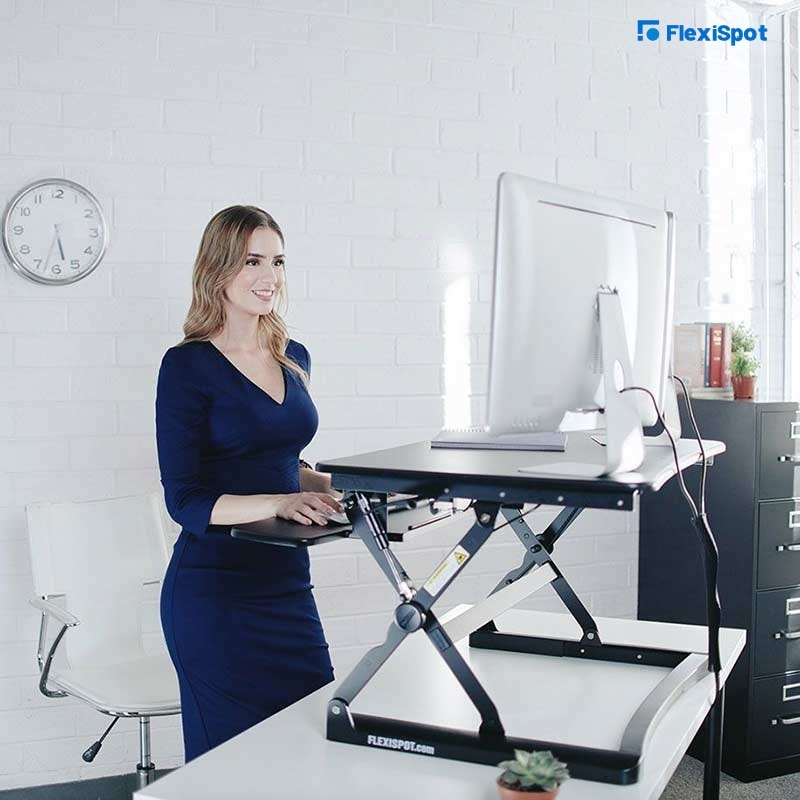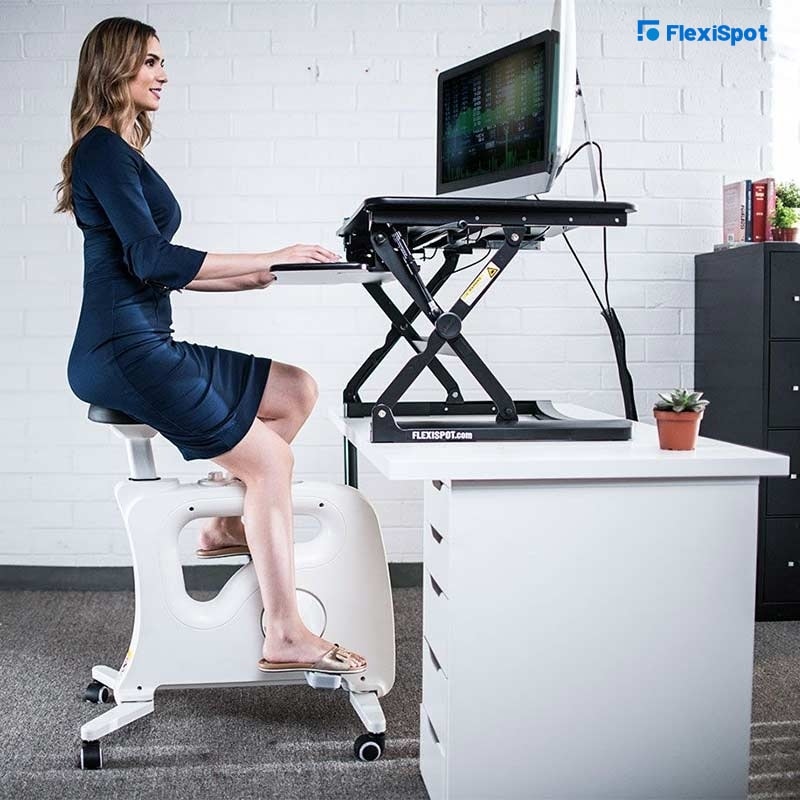It's no secret that office work can be tough on your body and can be a pain in the neck, literally. Whether you're hunched over a keyboard all day, constantly twisting to reach files on a high shelf, or maintaining a poor sitting posture while working, you're at risk of developing neck and back pain.
In today's fast-paced world, it's all too easy to neglect our physical well-being in favor of working longer hours. And we might not even realize this until it's late, but these actions can lead to long-term pain in those areas, which can later affect your productivity and comfort at work.
In fact, studies show that up to 80% of people will experience some form of neck or back pain in their lifetime for various reasons. While some causes of pain may be beyond our control, there are still many things we can do to minimize the risk of discomfort.
Today we'll explore some of the minor changes you can make in your office and home environment to avoid neck and back pain. We’ll highlight some personal cultural shifts you can take outside the office to alleviate neck and back stains–it promises to be an article jam-packed with positivity. So, without further ado, let's start by looking at what could be behind your neck and back pain.

What Are the Most Common Causes Of Neck and Back Pain in the Office?
Neck pain can compromise your range of motion and interfere with your daily life. Even turning your head to answer a question or check traffic becomes a painful experience. Most cases of neck pain resolve on their own in a few days or, at most, a few weeks, but it's best to avoid the pain altogether. Here are a few issues to take note of:
Sleeping in an Awkward Position
How It's a Problem
We've all been there before–we wake up in the morning with a crick in our neck or a pain in our back. More often than not, this results from sleeping in an awkward position. When we contort our bodies into unnatural positions, it puts pressure on our muscles and joints, which can lead to pain and stiffness. In addition, sleeping in an awkward position can also restrict blood flow and compress nerves, both of which can contribute to pain.
Quick Fix
So if you're finding yourself waking up with a sore neck or back, it may be time to rethink your sleep position and location. To avoid back and neck pain, it is important to sleep in a position that keeps your spine in alignment. The best way to do this is to sleep on your back or on your side.
Remember to invest in a quality, supportive pillow and firm mattress that perfectly supports the neck and spine. Also, avoid sleeping in less-than-ideal places, such as on your office desk, in your car, on airplanes, on the sofa, or on the recliner. You can also invest in a travel-style memory foam pillow to avoid neck and back strain if traveling is an unavoidable part of your office work.
RSI (Repetitive Strain Injury)
How It's a Problem
Back and neck pain are common symptoms of RSI or repetitive strain injury. RSI is a condition that occurs when the muscles, tendons, and nerves in the body are overused. This can happen when a person performs the same movement over and over again, such as typing on a keyboard or using a mouse.
The more you do it, the worse it gets!
Quick Fix
First, it is important to identify the source of the problem. If your work requires you to perform repetitive motions, look for ways to modify your task or take breaks throughout the day to stretch and move around. Even simple exercises like standing up and reaching for the ceiling can help to loosen tight muscles and relieve tension. Second, use ergonomic devices to reduce strain on your joints. For example, an ergonomic keyboard can help reduce strain on your wrists and hands.
Cervical Osteoarthritis
How It's a Problem
Osteoarthritis and other arthritic conditions come as a risk factor as we age. It wears out the cartilaginous layers that cushion your vertebrae from strain and stress. Without such a layer, you get loads of bone-to-bone and muscle-to-muscle contact, which is quite painful. So, your neck and back pain could result from undiagnosed conditions.
Quick Fix
Sadly, Osteoarthritis is unpreventable in some cases. But, the discomfort is quite manageable.
First, it is important to maintain good posture and alignment. This can help to take pressure off of the joints in the neck and spine. Second, gentle exercises can help to stretch and strengthen the muscles around the affected joints. Finally, over-the-counter or prescription medications may be necessary to control pain and inflammation. Embracing a healthier diet with loads of fiber and quitting smoking and drinking can also enhance your efforts.
Stress
How It's a Problem
Stress is a common cause of back and neck pain in the office. When we're under stress, our bodies release cortisol and adrenaline. These hormones cause our muscles to tense up, which can lead to pain in the neck, back, and shoulders.
The longer you take to address your stress, the worse such nervous aches and pains get. Eventually, it can become the source of loads of chronic pain.
Quick Fix
The best way to prevent stress from compromising your neck health is to learn to manage it. Yoga, meditation, deep breathing, delegating work, and self-care — such as regular massages and baths — can help you relax and give your neck a break.
Another stress-busting tip is to make time for yourself outside of work. Whether it's going for a walk in nature or reading your favorite book, taking some time for yourself each day can help you feel more relaxed and refreshed. Finally, try to establish some healthy sleep habits. Getting enough rest is crucial for managing stress levels and reducing pain.
Poor Posture
How It's a Problem
Poor posture harms you by putting excessive force and strain on the supportive joints and tissues. The longer you adopt an unnatural posture, the more the stiffness sets in and the tenser the neck and back muscles get.
Quick Fix
Leading a less sedentary office life helps. But, there are no quick fixes for such an issue. The solution lies in addressing workplace ergonomics and learning how to sit, stand, sleep, and walk in a proper posture.

Can Adjusting Your Workstation Prevent or Alleviate Neck Pain?
Even with an improved diet, frequent walks, and stretches, you may still have to sit at a desk as it's an unavoidable part of office work. Fortunately, you can make your workstation a healthier and more functional space by addressing a few ergonomic concerns.
Here are some tips to get the ball rolling:
Setting up your screen: If your computer screen is too high or low, this could contribute to shoulder or neck fatigue at the end of a long day. The top of the screen should be set at eye level, so you do not have to look up or down consistently.
Get a monitor arm: to give you more autonomy over computer monitor placement. This ensures you can adjust the screen to meet you at eye level. Hence, you avoid the strain that piles up on your cervical column and related muscles.
Ergonomic office chair: Consider getting an ergonomic office chair with proper lumbar support and armrests. The ideal office chair is adjustable enough to position your thighs and knees horizontally to your hips. This also improves blood circulation from the legs (placed on a comfortable footrest) to the rest of the body.
Avoid reckless multitasking: The best example is talking on the phone while typing on a laptop or desktop computer. We typically cradle the handset between our shoulders and a craned neck during such times.
Sure, it's okay to do this for a short period. But, there's never telling how long a call can last, and doing it every day causes strain that can grow into chronic pain. One way to beat this is by answering the call on speaker or using a headset.
You can also stop typing and focus on the call till the end. Alternatively, take the opportunity to walk out of the office and stretch a little while giving the caller your full attention.
Keyboarding and typing techniques: If typing on a computer wears you out, it has everything to do with how you position your back and arms. To beat this, adjust your keyboard's height to meet your elbows at a 90-degree angle. Then rest your elbows on the armrests and adjust the chair’s back for access and optimal comfort.

How Can You Prevent These Types Of Pain From Occurring In The First Place?
Get A Standing Desk
The chief cause of neck and back pain is leading a sedentary office life. This implies intentionally sitting for long periods with little physical activity or mobility. We were not designed to sit around all day. And we can't evolve into such a role.
So, the best way to stay ahead of chronic neck, back, and pain in other regions is changing your position throughout the work day. And this is where a sit-stand desk comes in.
Height adjustable or sit-stand desks allow you to interchange between sitting and standing. This lets you straighten your spinal column to alleviate back and neck discomfort. And, you don't have to stop working!
You can also throw an under-the-desk treadmill to get a little cardio in as you stand.
Practice Good Posture
There are a few simple things that you can do to practice good posture and reduce your risk of pain:
First, make sure that your chair is at the proper height. Your feet should be flat on the ground, and your knees should be at a 90-degree angle.
Keep your shoulders back and down at chin level with your back against the backrest. Such positioning keeps your head in a neutral position, i.e., your ears remain above your shoulders. This reduces neck strain that goes further down your back.
Don't slouch; sit up tall and try to avoid rounding your back.
The keyboard should be close enough for you to maintain your elbows and back in the "golden 90-degree angle. This ensures you don't slump and strain your spine.
Limit Phone Screen Time
You raise and bend your head forwards while reading emails or doing other things on your phone or tablet. Sure, you probably don't do this for hours, but such repetitive motions have a cumulative effect on the neck, eye, and back strains.
The long-term effect can even lead to debilitating chronic pain. We can't eradicate the use of phones, but you can limit such screen time by electing to answer emails, IMs, and other bits of communication on a desktop app in your ergonomic office desk and chair, instead of your smartphone. This promotes good posture and proper blood circulation.
Take Frequent Breaks
Staying mobile is an integral part of protecting your neck and back muscles. Most office jobs limit your mobility. So, you can move around during your lunch break instead of eating alone at your desk. Or do this by walking to the water cooler. You can also walk to a coworker's workstation to talk briefly over collaborations instead of sending an IM.
You can look into gadgets and apps that improve your posture by reminding you to take frequent breaks. For instance, you can download the Pomodoro app to your phone. Such an application features friendly reminders alerting when it's time to take a break and flex a little.
Stay Well Hydrated
Plain old drinking water is a magic elixir. It contains minerals and electrolytes that nourish and energize the body throughout the day. But did you know that water hydrates spinal disks and the spongy structures that make them limber?
This is because we're made of over 70% water. And loads of this water are concentrated on bone joints and cartilage. It also dilutes synovial fluid, making disks stronger, more agile, and pliable.
The Surgeon General recommends at least eight sizable glasses of drinking water every day. You can ensure you meet such a threshold by keeping a water bottle handy on your desk. This saves you from frequent walks to the office kitchen or water cooler when you're busy.
It's also advisable to chug 2 to 3 glasses of water after or with every meal - Every little bit helps!
Additional Lumbar Support
The Lumbar support on typical office chairs may not give the comfort some people need while working. This is especially true for pregnant women, workers undergoing physical rehabilitation, and people with specific disabilities.
In such cases, it may be advisable to get a lower back lumbar support pillow. You'll feel relief once you place it between your office chair and back. You can also avoid some of this pain by sitting on a yoga ball, which re-aligns your spine.
Use Proper Lifting Techniques
Whenever you lift something heavy, be sure to use proper lifting techniques to avoid injuring your back. Bend at your knees, not at your waist, and keep the object close to your body as you lift it.

What Are Some Tips for Relieving Neck and Back Pain when It Occurs?
Relieve Trigger-Point Pain
What is trigger-point pain?
Trigger points are areas of muscle tissue that have become irritated and inflamed. This can result in knots or spasms, which can cause pain and stiffness in the surrounding area.
Fortunately, there are several things you can do to relieve trigger-point pain. First, try gently stretching the affected muscle group. You can also use a tennis ball or foam roller to massage the trigger point.
You can elect to use a muscle relaxer or anti-inflammatory medication to relieve the pain. It's available over the counter. But, insist on using it under clinical supervision as such drugs contain receptor inhibitors that can lead to higher blood pressure or hypertension.
You can also perform some neck stretches and exercises while on a break. And a restful night's sleep or a personal spa day is an equally brilliant solution.
Minimize the Load You Carry on a Daily Basis
Carrying a heavy bag or briefcase can lead to neck and back pain, especially if you're lugging it around the office all day. Here are some tips to help lighten the load and reduce your discomfort:
Be selective about the type of bag you use. If possible, use a backpack instead of a shoulder bag. This will distribute the weight more evenly and take some of the strain off your neck and back.
Check the contents of your bag or briefcase regularly to see if there's anything you can leave at home or on your desk. Do you really need that extra notebook?
Use a smaller bag or briefcase. It's tempting to carry everything, but if you use a smaller bag, it can force you to limit the amount of things to the essentials.
Finally, make sure you're using both hands when carrying your bag. This will help to balance the load and ease the strain on your body.
See a Physical Therapist
If you’re experiencing neck or back pain that doesn’t go away with self-care, be sure to see your doctor or a spine specialist for further evaluation and treatment. Another viable alternative to medicine and physiotherapy is a combination of chiropractic care and deep tissue massage.
Conclusion
Please don't reach out for over-the-counter painkillers and antihistamines on the first sign of neck and back pain. This only provides temporary relief without addressing the root cause of the issue. But, hopefully, after reading this, you have the perfect place to start.
It's all about factoring in the entirety of your workplace ergonomic concerns and injecting a spot of physical activity during the day. Also, remember to have some fiber in every meal and keep your body hydrated.
We'd also be remiss if we didn't encourage you to take a break and spoil yourself with personal care every once in a while. It can do wonders for your health!